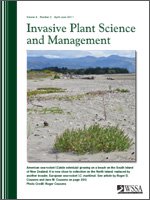Black and pale swallowwort (BSW and PSW, respectively) are perennial, herbaceous vines in the Apocynaceae that are native to Europe. The species are becoming increasingly abundant in the northeastern United States and southeastern Canada and are difficult to manage. However, we know little about the demographic parameters of these species. We determined the survival, annual rate of vegetative growth, and fecundity of mature clumps of these swallowwort species. We selected four PSW sites (three of which comprised both old-field and forest habitats) in central New York and three BSW old fields in southeastern New York. BSW is largely restricted to higher light habitats in its introduced range. In each habitat, we followed the growth of 30 to 32 randomly selected clumps of similar size (2 to 5 stems clump−1 in the initial year) for 3 to 4 yr. Yearly survival was 99.6 ± 0.3% [mean ± standard error] for PSW and 100 ± 0% for BSW. In old fields, vegetative expansion varied from −0.01 ± 0.1 to 4.6 ± 0.4 stems clump−1 yr−1 for BSW and −0.02 ± 0.2 to 2.1 ± 0.5 stems clump−1 yr−1 for PSW. In forests, PSW growth was lower with vegetative expansion ranging from −0.01 ± 0.1 to 0.8 ± 0.2 stems clump−1 yr−1. Fecundity of PSW in 2007 and 2008 (130 ± 10 viable seeds stem−1 yr−1) was similar to BSW (100 ± 10 viable seeds stem−1 yr−1). Fecundity of PSW in forests was generally lower than PSW in old fields, but it varied greatly among sites (0 to 170 viable seeds stem−1 yr−1). We found that stem growth and fecundity did not vary with clump size (stems per clump). Since vegetative expansion and fecundity rates were high in old-field habitats, but were generally low or nonexistent in forest habitats, we suggest that management of these two invasive vines be focused in higher light environments to reduce overall seed production and its subsequent spread to surrounding areas.
Nomenclature: Black (or Louise's) swallowwort, Vincetoxicum nigrum (L.) Moench., syn. Cynanchum louiseae Kartesz & Gandhi; Pale (or European) swallowwort, Vincetoxicum rossicum (Kleopow) Barbar., syn. Cynanchum rossicum (Kleopow) Borhidi
Interpretative Summary: Black swallowwort (BSW) and pale swallowwort (PSW) are climbing herbaceous perennials related to milkweeds. Although both vines were introduced from Europe into the northeastern United States and southeastern Canada in the latter 1800s, they increasingly have become problematic in the last 20 yr. Many gaps remain in our knowledge of swallowwort field biology, which can vary by plant species and habitat. We found that nearly all mature plants survived during a 4-yr field study in New York in which we tracked individual plants in relatively low-density stands in old fields (BSW and PSW) and forest understories (PSW only). We rarely have observed BSW in heavily shaded forests. Both species annually increased in size through the production of additional stems, and this was generally similar for PSW and BSW in old fields and much less for PSW in forests. BSW and PSW in old fields also produced the same amount of viable seed, but PSW in forests produced less seed. However, both reproduction and vegetative expansion by PSW in forests varied greatly, depending on the amount of light within the forest. Based on our findings in this study, it does not appear that the two species should require different strategies for management. We suggest that management of swallowwort should be focused in higher light environments, where vegetative growth and reproduction is greatest, to reduce seed production and thereby minimize its spread to other habitats.






